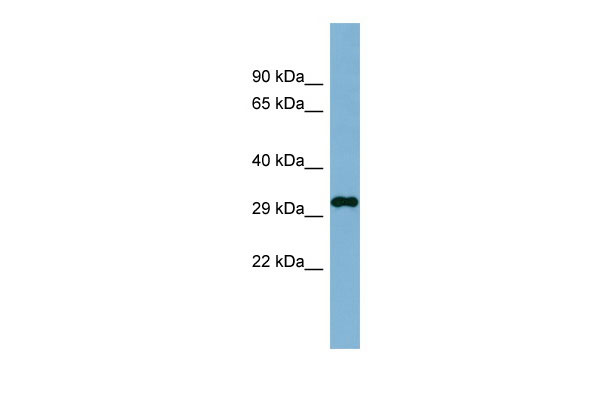C20orf116 antibody - N-terminal region
Rabbit Polyclonal Antibody
- 产品详情
- 实验流程
Application
| WB |
|---|---|
| Primary Accession | Q96HY6 |
| Other Accession | NM_023935, NP_076424 |
| Reactivity | Human, Rabbit, Dog, Horse, Bovine |
| Predicted | Human, Rabbit, Dog, Horse, Bovine |
| Host | Rabbit |
| Clonality | Polyclonal |
| Calculated MW | 35611 Da |
| Gene ID | 65992 |
|---|---|
| Alias Symbol | MGC2592, dJ1187M17.3, UFBP1, C20orf116 |
| Other Names | DDRGK domain-containing protein 1, UFM1-binding and PCI domain-containing protein 1, DDRGK1 (HGNC:16110) |
| Format | Liquid. Purified antibody supplied in 1x PBS buffer with 0.09% (w/v) sodium azide and 2% sucrose. |
| Reconstitution & Storage | Add 50 ul of distilled water. Final anti-C20orf116 antibody concentration is 1 mg/ml in PBS buffer with 2% sucrose. For longer periods of storage, store at 20°C. Avoid repeat freeze-thaw cycles. |
| Precautions | C20orf116 antibody - N-terminal region is for research use only and not for use in diagnostic or therapeutic procedures. |
| Name | DDRGK1 {ECO:0000303|PubMed:20228063, ECO:0000312|HGNC:HGNC:16110} |
|---|---|
| Function | Component of the UFM1 ribosome E3 ligase (UREL) complex, a multiprotein complex that catalyzes ufmylation of endoplasmic reticulum-docked proteins (PubMed:30626644, PubMed:32160526, PubMed:35753586, PubMed:36121123, PubMed:36543799, PubMed:37595036, PubMed:37795761, PubMed:38383785, PubMed:38383789). The UREL complex plays a key role in ribosome recycling by mediating mono-ufmylation of the RPL26/uL24 subunit of the 60S ribosome following ribosome dissociation: ufmylation weakens the junction between post-termination 60S subunits and SEC61 translocons, promoting release and recycling of the large ribosomal subunit from the endoplasmic reticulum membrane (PubMed:38383785, PubMed:38383789). Ufmylation of RPL26/uL24 and subsequent 60S ribosome recycling either take place after normal termination of translation or after ribosome stalling during cotranslational translocation at the endoplasmic reticulum (PubMed:37595036, PubMed:38383785, PubMed:38383789). Within the UREL complex, DDRGK1 tethers the complex to the endoplasmic reticulum membrane to restrict its activity to endoplasmic reticulum-docked ribosomes and acts as an ufmylation 'reader': following RPL26/uL24 ufmylation, DDRGK1 specifically binds to ufmylated RPL26/uL24 via its UFIM motif, resulting in stable association between the 60S ribosome and the UREL complex, followed by dissociation of the 60S ribosome subunit from the endoplasmic reticulum membrane (PubMed:36121123, PubMed:37595036, PubMed:38383785, PubMed:38383789). The UREL complex is also involved in reticulophagy in response to endoplasmic reticulum stress by promoting ufmylation of proteins such as CYB5R3 and RPN1, thereby promoting lysosomal degradation of ufmylated proteins (PubMed:32160526, PubMed:36543799). Ufmylation-dependent reticulophagy inhibits the unfolded protein response (UPR) by regulating ERN1/IRE1- alpha stability (PubMed:28128204, PubMed:32160526). Acts as a regulator of immunity by promoting differentiation of B-cells into plasma cells: acts by promoting expansion of the endoplasmic reticulum and regulating the unfolded protein response (UPR) (By similarity). May also be required for TRIP4 ufmylation (PubMed:25219498). May play a role in NF- kappa-B-mediated transcription through regulation of the phosphorylation and the degradation of NFKBIA, the inhibitor of NF- kappa-B (PubMed:23675531). Plays a role in cartilage development through SOX9, inhibiting the ubiquitin-mediated proteasomal degradation of this transcriptional regulator (PubMed:28263186). Required for stabilization and ufmylation of ATG9A (By similarity). |
| Cellular Location | Endoplasmic reticulum membrane; Single-pass membrane protein |
| Tissue Location | Widely expressed (at protein level). In the brain, highest levels in medulla oblongata, followed by cerebral cortex, cerebellum and frontal lobe. |
Research Areas
For Research Use Only. Not For Use In Diagnostic Procedures.
Application Protocols
Provided below are standard protocols that you may find useful for product applications.
REFERENCES
Clark H.F.,et al.Genome Res. 13:2265-2270(2003).
Deloukas P.,et al.Nature 414:865-871(2001).
Mural R.J.,et al.Submitted (SEP-2005) to the EMBL/GenBank/DDBJ databases.
Tatsumi K.,et al.J. Biol. Chem. 285:5417-5427(2010).
Wu J.,et al.J. Biol. Chem. 285:15126-15136(2010).
终于等到您。ABCEPTA(百远生物)抗体产品。
点击下方“我要评价 ”按钮提交您的反馈信息,您的反馈和评价是我们最宝贵的财富之一,
我们将在1-3个工作日内处理您的反馈信息。
如有疑问,联系:0512-88856768 tech-china@abcepta.com.























 癌症的基本特征包括细胞增殖、血管生成、迁移、凋亡逃避机制和细胞永生等。找到癌症发生过程中这些通路的关键标记物和对应的抗体用于检测至关重要。
癌症的基本特征包括细胞增殖、血管生成、迁移、凋亡逃避机制和细胞永生等。找到癌症发生过程中这些通路的关键标记物和对应的抗体用于检测至关重要。 为您推荐一个泛素化位点预测神器——泛素化分析工具,可以为您的蛋白的泛素化位点作出预测和评分。
为您推荐一个泛素化位点预测神器——泛素化分析工具,可以为您的蛋白的泛素化位点作出预测和评分。 细胞自噬受体图形绘图工具为你的蛋白的细胞受体结合位点作出预测和评分,识别结合到自噬通路中的蛋白是非常重要的,便于让我们理解自噬在正常生理、病理过程中的作用,如发育、细胞分化、神经退化性疾病、压力条件下、感染和癌症。
细胞自噬受体图形绘图工具为你的蛋白的细胞受体结合位点作出预测和评分,识别结合到自噬通路中的蛋白是非常重要的,便于让我们理解自噬在正常生理、病理过程中的作用,如发育、细胞分化、神经退化性疾病、压力条件下、感染和癌症。






